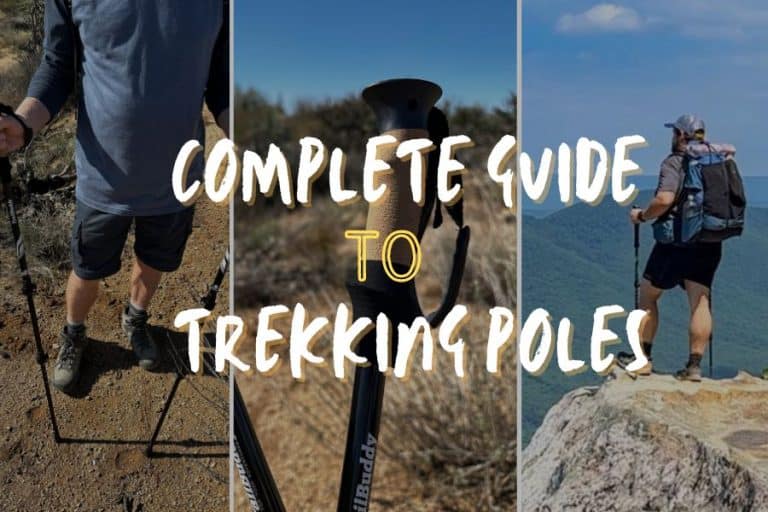I have a love-hate relationship with trekking poles. I need them to cross creeks, feel for rocks, and make my hike safer.
But I also carry a lot of video camera equipment that makes the trekking poles a hassle to take with me.
Still, trekking poles serve a great purpose in the hiking world, most notably helping to avoid unnecessary injury.
So you might be asking yourself…do I need trekking poles? And If so, what kind should I get?
Well, in this guide to trekking poles, I’ll cover anything and everything you need to know about them!
Table of Contents
ToggleTypes of Trekking Poles
Different trekking poles are available for all sorts of user needs.
Knowing about the different types is a good idea because you might need specific features in a trekking pole.
You wouldn’t think there is much to them, but there is.
For example, as I said, I carry a lot of video gear, so a trekking pole that can extend down to make it easier to carry is critical for me to be able to use; otherwise, I’ll be one significant walking hazard with all sorts of stuff in my hands.
So, let’s take a look at some of your options!
Telescopic Poles
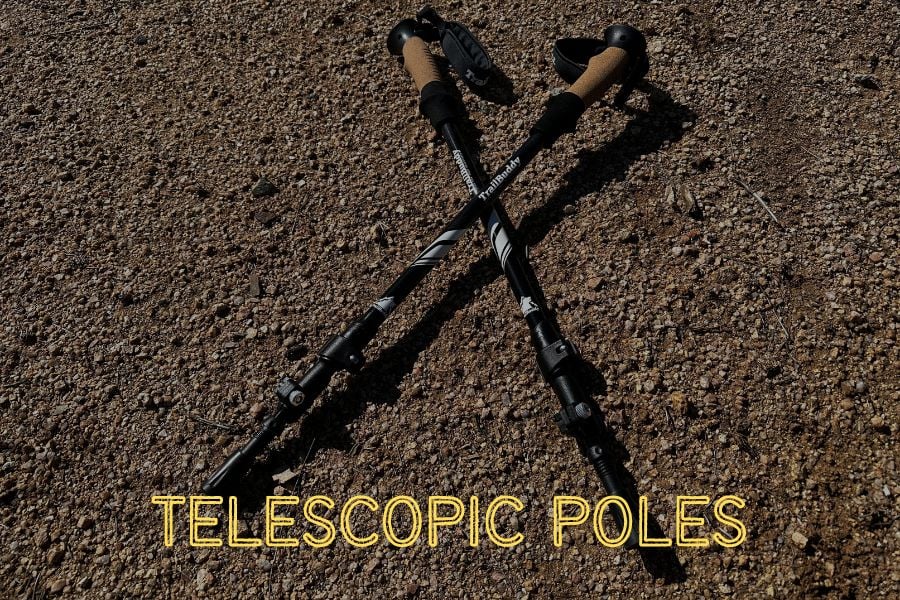
You might need a trekking pole that you can adjust to pack away when you don’t need it.
Telescopic poles are retractable hiking sticks. They allow you to adjust the height of the pole and then lock it in place.
This is convenient if you don’t always need to pole or if you need to adjust the pole for your height and position needs.
These hiking poles are common and, therefore, widely available where most hiking gear is sold.
If you need a trekking pole that can adjust to your needs, then a telescopic pole is what you want to look for.
I love telescopic poles! Like I said before, I carry too much camera gear to worry about having a trekking pole.
So, I can collapse my telescopic pole inward enough to store it on my hiking pack when I’m not using it. And then it is easy to access when I need it the most.
Fixed-Length Poles
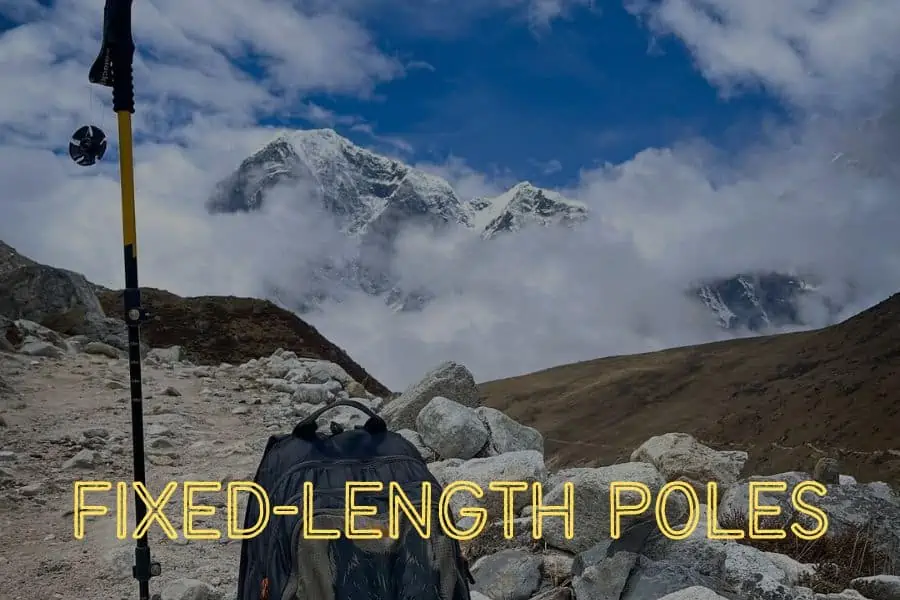
Fixed-length poles are great for people who constantly need to use a trekking pole.
A fixed-length pole is the complete opposite of a telescopic pole. It doesn’t adjust at all. It is one length, and that is all you get.
This pole option will benefit you if you always need to use your trekking pole. Maybe you have balance issues, and you need that help.
Maybe you’re hiking on technical trails that require the pole to be used all the time.
While I don’t use fixed-length trekking poles, I still find them very useful for the users who need them.
Since they don’t expand, there are no weak points in the pole. Any adjustable point isn’t solid and, therefore, weak even if the product is manufactured to be strong.
If you need a usable trekking pole for the entire hike, then a fixed-length option is likely what you want.
Folding Poles
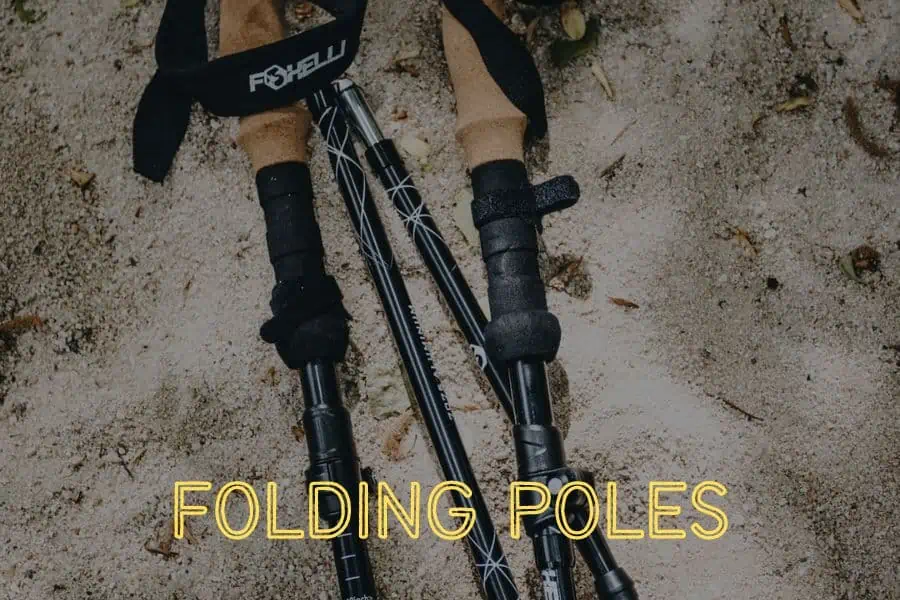
A folding pole is much like a telescopic pole, but doesn’t give you adjusting features.
A folding pole breaks down like a tent pole.
You can’t adjust the height and lock them like you can with a telescopic pole, but you can still fold it and store it easier when you’re not using it.
I would use a folding pole for occasions when I know I’ll only use the trekking pole once during the trip, such as crossing a creek or stream.
But for the most part, I’d rather have a telescopic pole for its adjustable locking features.
Folding poles are a more challenging option to be available. I’ve only ever seen telescopic and fixed-length poles in most stores that I’ve been to.
Trekking pole parts and materials
Trekking poles seem pretty straightforward, but there are a lot of parts and materials that go into them.
Understanding the different materials of a trekking pole and the parts is essential in getting the best use out of them.
You want to know how your pole works to use it properly.
You also want to know how it was made because it can help you determine what you need for your hiking style.
One of the most valuable things I know about trekking poles is the material that poles are made from.
It can give me an idea of the pole’s weight, which is essential since my body carries that weight.
So, let’s look at what trekking poles are made of and their standard features.
Shaft: Carbon vs. Aluminum Poles
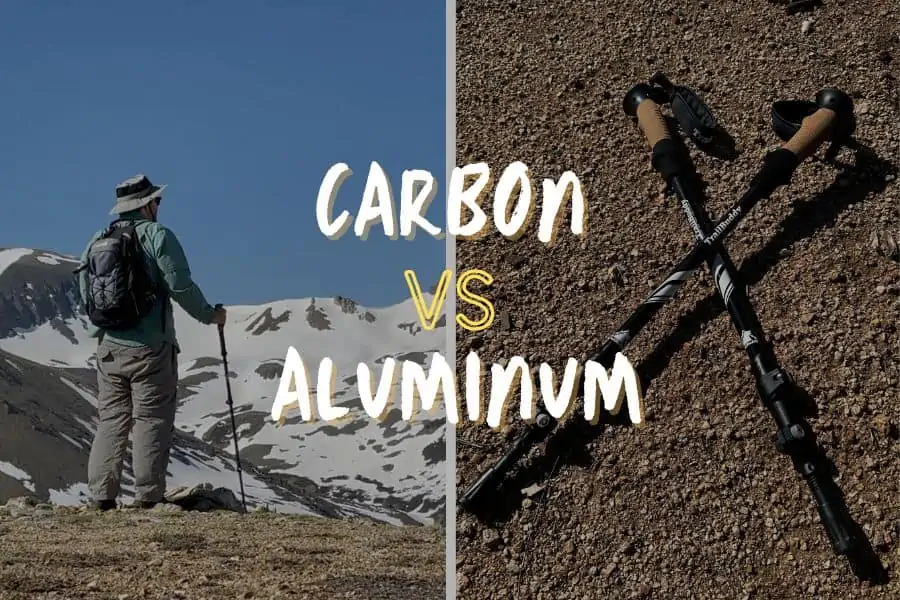
There are two main types of materials used to create the shaft of a trekking pole.
The first type of material is carbon fiber, a very lightweight metal material.
Most high-quality road bicycles are made from this material if you’re familiar with them.
It is one of the lightest materials around.
Aluminum is the other common material used to create a shaft of a trekking pole.
It is heavier than carbon and also more widely available than carbon is, especially in retail stores.
I would recommend a carbon pole over any other type. That’s because it is so lightweight.
The lighter your gear is, the easier it is on your body. But carbon is usually expensive.
That is the drawback of using it over a standard and less costly pole like an aluminum one.
But it is a more accessible item to get that weighs less.
Carbon is the most lightweight option, but an aluminum pole will be dramatically cheaper.
Locking Mechanism
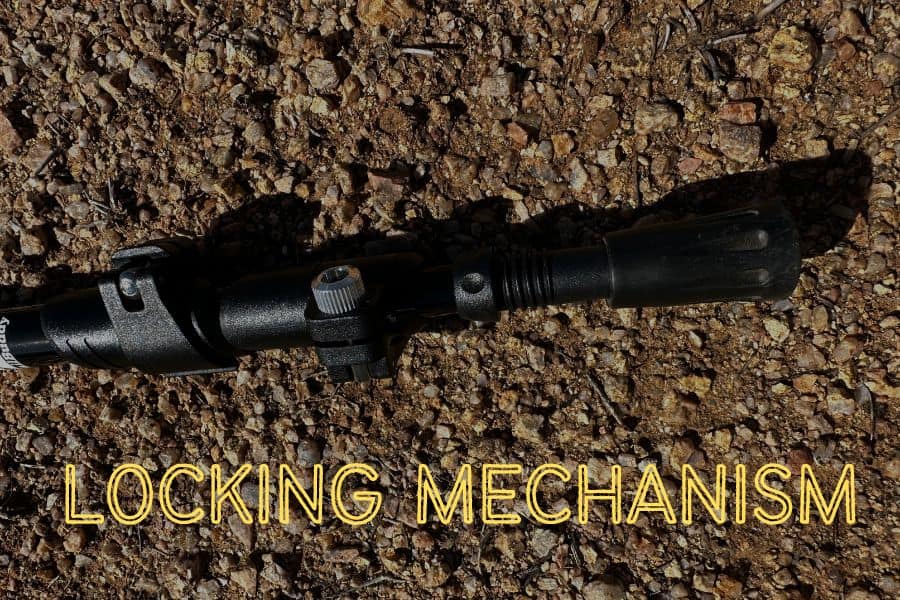
The locking mechanism on a trekking pole is one of the essential safety features to understand fully.
Understanding how to use the locking mechanism will ensure that you can secure the trekking pole into the locked position before use.
If it isn’t secure and you lean into the pole, it might become unadjusted or collapse, causing you to fall.
That can be very hazardous depending on your body position and other hazards you might be around.
Most packaging will show you how to lock the trekking pole into place securely.
If the package doesn’t have it, check YouTube because it is most likely on there.
Learn how to use the locking mechanism to prevent injury if it fails because you didn’t secure it correctly.
Grip
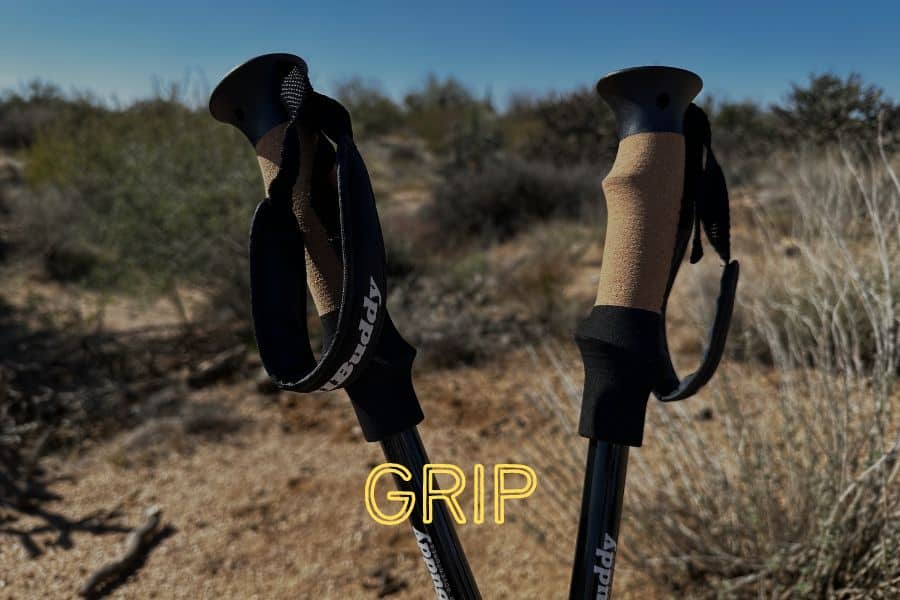
Knowing what materials are used on a trekking pole’s grip can help with comfort.
Some trekking poles use a standard rubber grip. Others might use a different material that is cheaper to produce than rubber.
Some poles may even have plastic grips. Understanding what material is used for the grip, how big the grip is, and the grip’s mold can help you find a comfortable pole for your needs.
I prefer a rubberized grip with tread on it so I can hold on to it better when I sweat.
If I sweat and the grip is smooth, it might slide out of my hand, and I could get hurt.
Something as simple as the grip can improve the hike, so look into the grip before choosing what trekking pole to use.
Straps
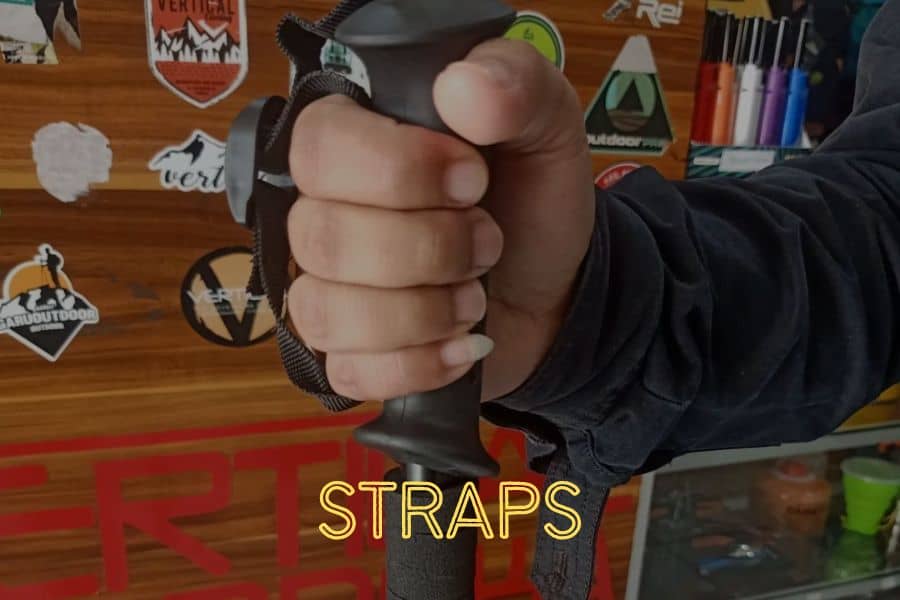
Straps can often be considered another vital safety feature on a trekking pole.
Straps can help you grip the trekking pole without relying entirely on the actual grip.
Many trekking poles offer adjustable straps to help them meet your specific gripping needs.
Some poles have basic straps. If you need more custom options, you can also purchase straps to put on poles.
Straps are helpful because they help me hang on the pole with my wrist if I need to bring it and use both hands to hold a camera or something like that.
I’d find it annoying to put the pole down and pick it back up constantly.
Trekking pole straps make life easier as a hiker.
Make sure you understand the features of the strap to meet any special needs you might have regarding gripping the pole.
How to Use Trekking Poles
Trekking pole instructions seem pretty self-explanatory. You’d be surprised to know that many people are using them the wrong way!
A trekking pole was invented for a specific task. Often, people add additional functions to gear that isn’t intended for those tasks.
That can cause the equipment to become unstable and potentially be a safety hazard for the person using it.
You should get a basic understanding of how to use a trekking pole before you start using it.
I’m a safety-oriented person. I like to understand the safety precautions of every product I use entirely.
A trekking pole is one of them.
This gear helps you sustain balance; if you misuse it, it can hurt you.
Here’s how to properly use trekking poles:
- Adjust the wrist strap
- Adjust the pole length
- Shorten the poles to walk uphill
- Lengthen to walk downhill
- Your elbow should be at a 90-degree angle when moving your pole forward.
Now let’s dive into each of these steps to use trekking poles in a bit more detail:
Adjusting and Using the Wrist Strap
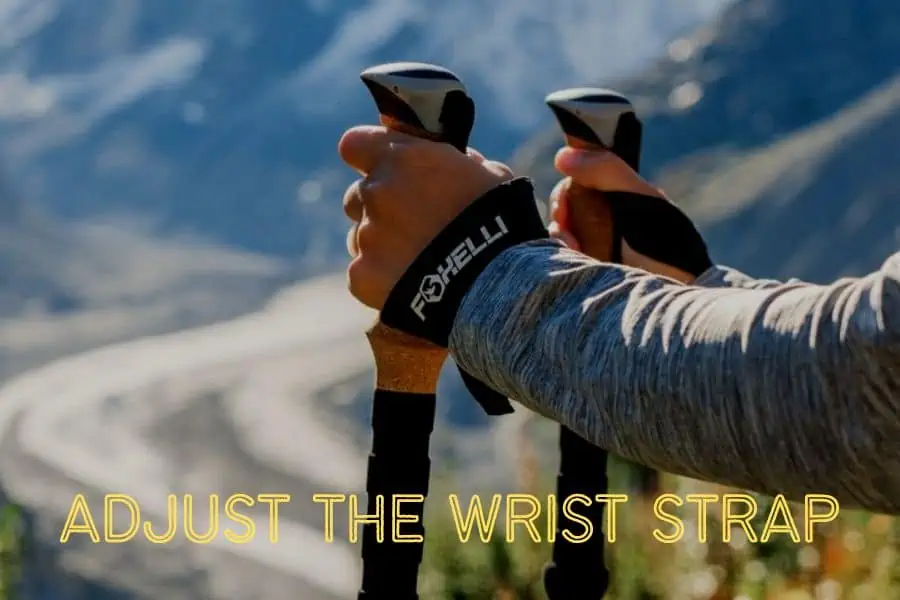
If you can adjust the wrist strap of your trekking pole, then you should do that to meet the needs of how you grip your pole.
Start by ensuring the strap is flat at the top and not twisted.
Some straps may have a lock on them and require you to pull up to unlock them and pull down to put them back into a locking position.
Usually, unlocking a strap will allow you to adjust the strap length you’ll put your hand into.
Pull the middle strap to make the loop bigger and the bottom strap to make the loop smaller.
Just make sure you lock it after you’ve found a good fit. Bring your hand up through the loop and down on the strap and grip to properly use your straps.
I like using the straps because it allows me to utilize other muscle groups in my hand to prevent strain.
It also helps control my hand from slipping on the grip when it becomes too sweaty. I tend to sweat more than most people because of my height.
Ensure you’re correctly using your strap before you use it to take advantage of its full benefits.
Adjust The Pole Length
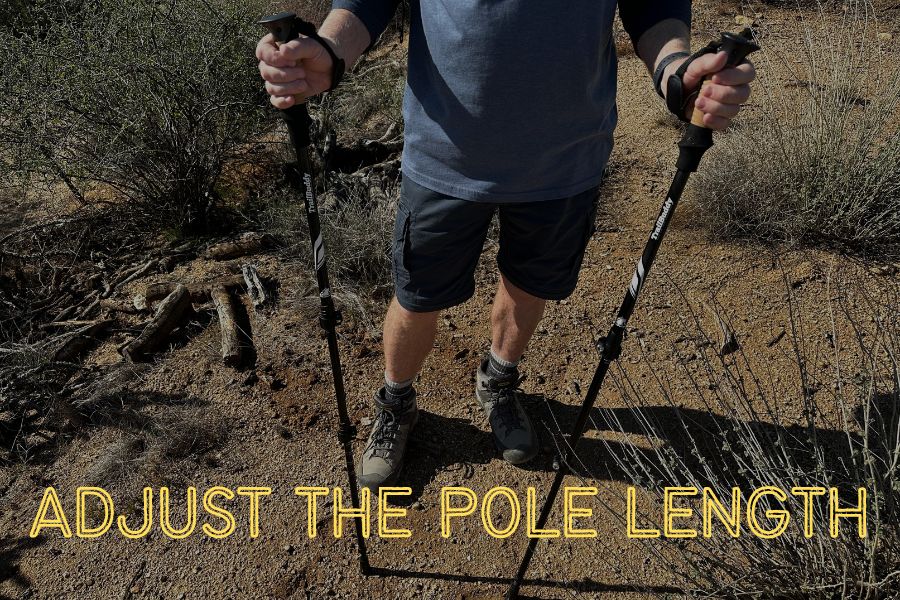
Before using an adjustable trekking pole, you should understand how to adjust it to benefit from what it offers.
The height of a trekking pole is going to be different for everyone. It depends on your size.
A majority of adjustable trekking poles will have brass or silver locking pins.
To adjust the length of the pole, you push in the pin and pull it up or down into other holes for it to lock into.
If you turn a portion of the pole, the pin may not align with the hole, so be sure you steady to upward or downward movement of your adjustment.
The pin needs to be able to lock into a hole for the pole to be safely used. Some poles twist to unlock and adjust rather than using a pinhole.
Try to adjust proportionally for each segment to balance the tork of the pole and make it last longer.
I’m 6’5” tall. I’m taller than most average-height people. I have to adjust every trekking pole to make my hiker comfortable.
If not, I might be required to slouch downward and strain my back and neck. That could lead me to get an unwanted injury.
Make sure you’re adjusting your trekking pole correctly to prevent yourself from getting a completely avoidable injury or strain.
Walking Uphill
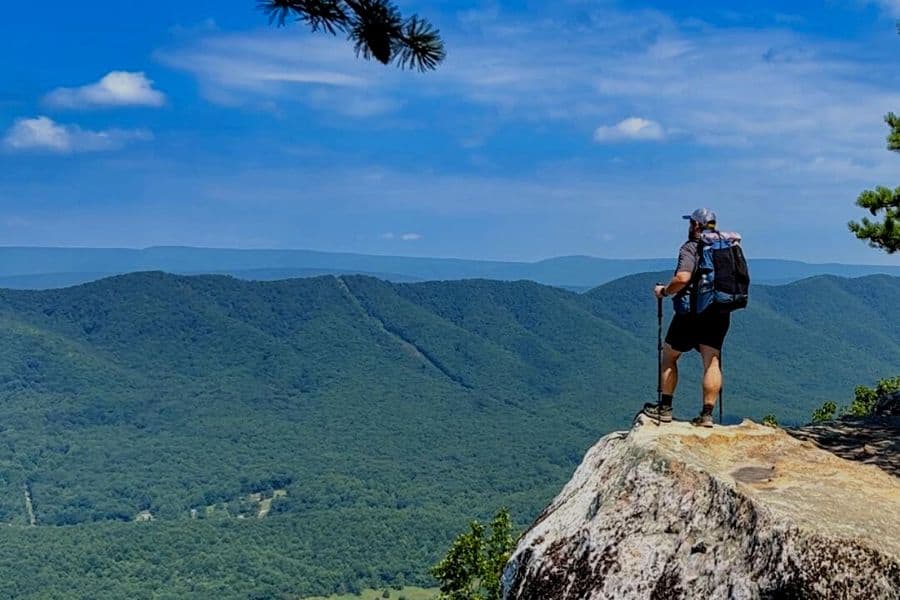
There are many different times when you may need to adjust your trekking pole. Going uphill is one of those times you should adjust the pole.
When going uphill, you want to prevent yourself from overstretching.
Overstretching could cause you to lose your balance, especially if your foot gets snagged or you trip over something accidentally.
You’ll want to adjust your trekking poles by shortening them up. This will keep you from having to overstretch more than you need to.
If you’re tall like me, you are overstretching could put a strain on your back and arms. Plus, my pack is a little heavier, which could cause issues with my balance.
Adjust your trekking pole when going uphill so you’re not straining. It is already a chore to walk up a hill in the first place – don’t add more to it.
Walking Downhill
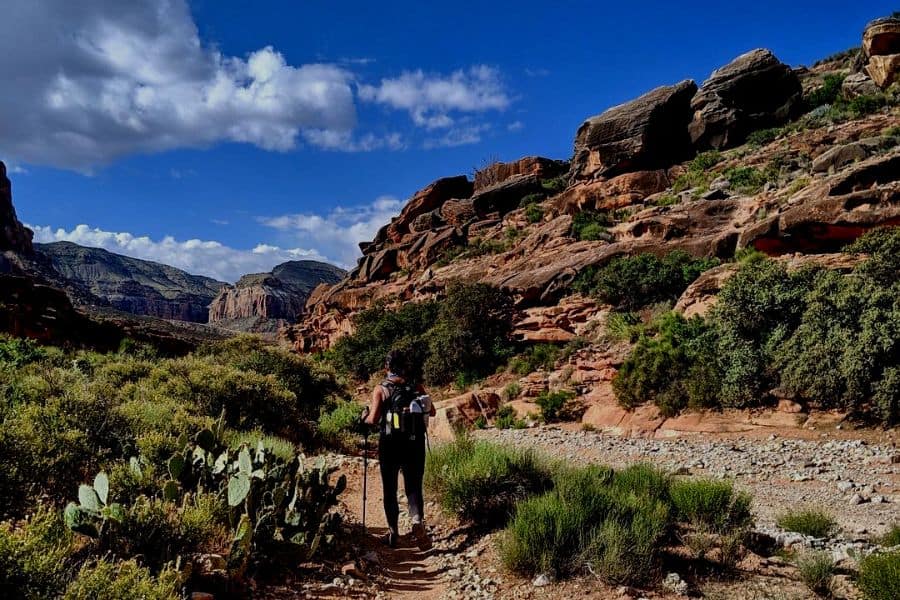
You also need to adjust your trekking pole for downhill use, too!
Downhill adjustments might be the most important of the trekking pole adjustments.
It is easier for you to fall going downhill than it is going uphill. So, you want to ensure you do everything you can to keep yourself safe when going downhill.
Adjust your trekking pole length to be longer when going downhill. This prevents you from having to bend down so much.
Bending down can cause you to lose your balance and potentially fall.
I also tend to walk sideways while using my longer-length pole to help balance when going downhill.
I’m a bit clumsy, to begin with, and carefully walking sideways while using the pole to assist me helps me safely move down the hill, especially when the terrain is rocky.
Adjusting your pole for downhill use is required to ensure you’re safe.
Moving The Pole Forward
There is a style to adopt when you use your trekking pole and move forward.
Your elbow should be at a 90-degree angle when moving your pole forward.
This can help you know how high or low you need to adjust the length of your pole.
The whole idea of a trekking pole is to take to the strain of your muscles and assist you with balance.
Hiking trails are only sometimes smooth or level terrain.
For example, if you’re walking on a slant, one pole may need to be shortened more than the other to position yourself while hiking correctly.
I ensure that I’m moving my pole forward instead of back as I hike. I’m often the leader of the hike.
I don’t want to hit someone with my trekking pole accidentally.
So, I’ve made it a habit to move to the pole forward and walk into the pole rhythm rather than backward.
Understanding how to use your trekking pole will make it easier for you and others hiking with you.
The Benefits (Why You Should Use Trekking Poles)
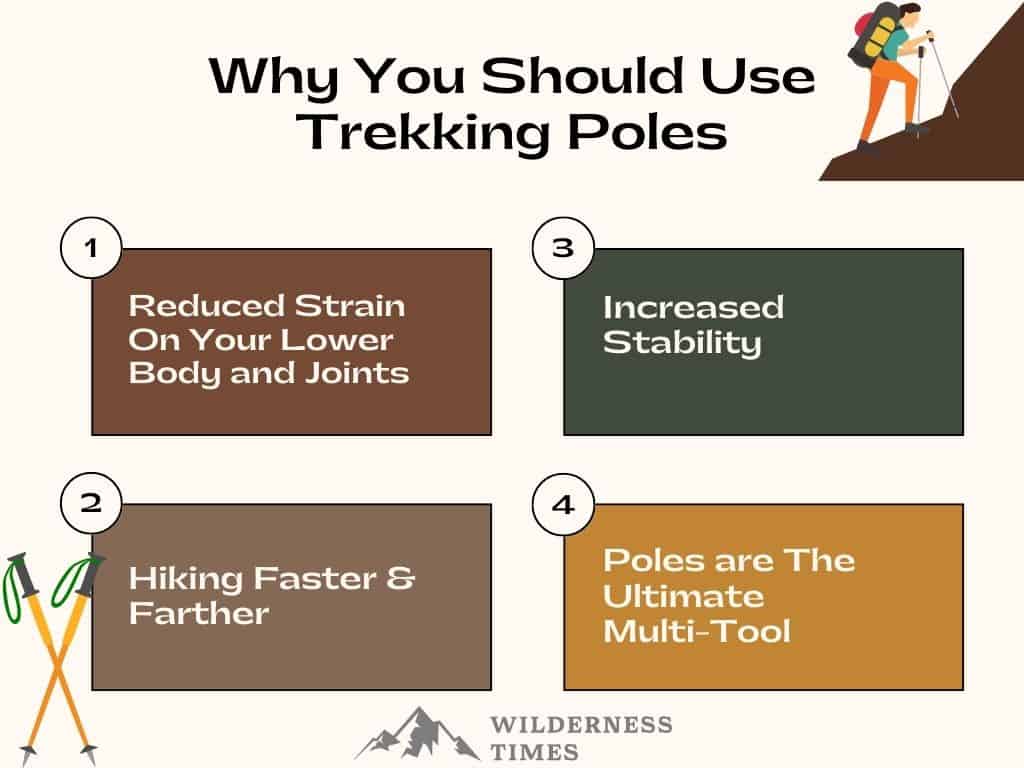
Should you or should you not be using trekking poles? Should you use one or two?
Not every hiker uses a trekking pole. Some use just one, while others sport one for each hand.
There are many benefits to using trekking poles. This is especially true if you have mobility or balance issues.
Hiking trails can be rough, and trekking poles can help ease the use of those trails.
For me, not every hike requires trekking poles. But there are many hikes I go on where I need them, and they come in handy.
So, they are vital gear to have for some trail use. I know other folks who can’t hike without them.
Let’s look at some of the main benefits of using trekking poles for hiking.
Reduced Strain On Your Lower Body and Joints
One of the main functions of a trekking pole is to reduce strain on your body and joints.
Trekking poles allow you additional balancing methods instead of just your body.
When hiking downhill without a trekking pole, you must bend more and use your body to ensure you don’t fall.
In general, that motion is causing some strain. But if you’re using trekking poles to assist you, you’re taking the pressure off your body by not having to do extra positioning to get down safely.
I’m tall, so getting up and down a hill without trekking poles is challenging.
I have to bend down and strain myself harder than most average-height people.
Tall people are known to have joint problems because of these issues.
Trekking poles can significantly reduce these problems.
To save your body and joints from straining, you must invest in trekking poles.
Increased Stability
Trekking poles will increase your overall stability and balance.
As I said earlier, most hiking trails are not easy or flat. Many better trails with more exciting points are rugged in terrain.
The ruggedness of these trails often includes rocks, roots, rolling hills, mountains, and creek crossings.
All these elements result in threats against your stability and balance.
Trekking poles act as extra tools to increase your stability and balance along trails like these because you rely on a tool instead of straining yourself to adapt.
Trekking poles are little miracles for me when I am crossing a creek.
The rocks are slippery, and I have to pay extra attention to them while bending my body in awkward ways to be able to balance on them to get across without falling in.
It’s even more challenging for us taller people.
Trekking poles will add significant balance and stability so I can focus on slowly moving across the rocks rather than trying to bend and balance without falling in.
If you want to increase your balance and stability on challenging trails, trekking poles are a must!
Hiking Faster & Further
Trekking poles can increase your ability to hike faster and longer distances.
Without trekking poles, you strain your body and muscles to stabilize and balance yourself, right?
You bend in awkward positions, overstretch, and have to use your brain to overcome natural obstacles.
Then you have to eat snacks and drink water because you’ve overworked yourself.
Add trekking poles to that, and you take most of that away.
That allows you to perform faster and go further distances because you’re not putting your body through such trauma as you go.
I learned this the hard way. For the longest time, I never used trekking poles.
Being so tall, I put much stress on myself that I could have avoided in the first place.
I’ve noticed a significant change for the better after using trekking poles along the more challenging trails I visit.
Trekking poles may be a vital tool if you want to improve your overall performance as a hiker.
Poles as The Ultimate Multi-Tool
Did you know that trekking poles can be used as survival tools?
A trekking pole is a great tool for stabilizing your hike and maintaining balance.
But this tool is a multi-tool all on its own. The most important uses for trekking poles as a multi-tool are instances where they can be used for survival.
Two examples are sheltering and predator warding. Let’s say you get lost and have to spend the night in the forest, and it starts to rain.
You can take a rain poncho or emergency blanket and create a shelter using your trekking pole to hold the middle part up.
If you encounter a predatory animal, your pole can be used as a weapon or a tool to scare the animal off.
Think about it; what other ways could you use your trekking pole?
I like to use my trekking pole to clear debris from the trail. If a branch, log, or rock isn’t there, I can move it with the pole.
Having to bend down and move can sometimes be a strain on my back because I’m wearing a backpack.
It caused me to get unbalanced to do that, and I might stumble.
It’s good to stretch our bodies from time to time when we aren’t sporting a heavy backpack!
Get some trekking poles if you want several tools in one to help reduce weight and increase efficiency.
Disadvantages (Why You Shouldn’t Use Hiking Poles)
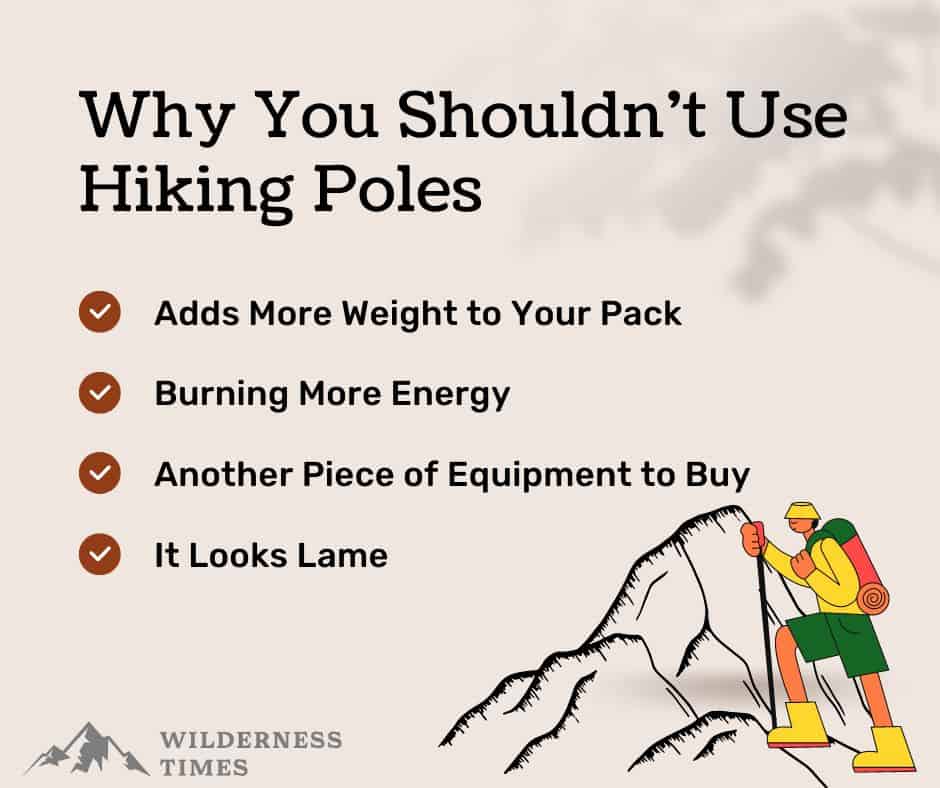
Trekking poles may not be for everyone, and they have some drawbacks.
While these tools are great for many different types of people, they’re not always as useful for other kinds of people.
It is essential to weigh the pros and cons of each piece of gear that you pack. Not all gear needs to be carried or used by every single hiker.
I don’t always pack trekking poles with me. There are a few occasions where they become more of a hassle to take with me than they are used for.
Let’s look at some disadvantages of using trekking poles.
Adds More Weight to Your Pack
Trekking poles will add weight to your pack.
Carbon fiber options are going to be the lightest, but they’re also going to be expensive.
They’ll like cost more than a hundred dollars. So, most people will go with aluminum poles because they’re often dramatically cheaper than carbon options.
But with aluminum comes more weight. If you require two poles, that’s even more weight.
I tend to carry just one trekking pole, but I won’t spend over a hundred dollars, so I go with the aluminum option.
If I were to use them all the time, I’d probably get a carbon fiber pole.
Ask yourself if it will be worth the weight addition before using trekking poles.
Burning More Energy
Trekking polls can help some people save energy, but others may burn more energy using them.
For some people, having to use poles and other gear they require will be an energy burner.
If the poles are made with heavier materials, that will burn your energy down. It is essential to watch how your energy changes after using trekking poles for a while.
You might need to hydrate more, take more breaks, or refuel sooner than usual.
My biggest issue is that the poles get in the way of having a free hand. I carry a video camera on a tripod and take many still photos, too.
Trekking poles are one more thing to manage while trying to do all the filming activities, and it burns energy because of that.
Will trekking poles help you save energy or burn energy? That is a question you should answer before investing in using them.
Another Piece of Equipment to Buy
Trekking poles are not always cheap!
Sometimes we can purchase substitute items for hiking to make it cheaper.
For example, a simple plastic fork is significantly more affordable than a hiking-specific fork.
But some hiking gear doesn’t have excellent substitutes.
Trekking poles are one of those! Most better-quality trekking poles will have a higher price tag, especially if you want them to be as lightweight as possible.
It is just one more piece of hiking gear to spend money on.
Before I buy any hiking gear, I ask myself if I will use it for what the price is worth.
Some things are just required by me, such as first aid gear, even if I never use it (hopefully that’s the case), but other non-essential items have to be considered.
I’m not particularly eager to spend money on things that will not get much use, and I’m sure you don’t either.
It Looks Lame
The least favorite of my disadvantages but one that many people agree with – trekking poles look lame!
Trekking poles are pretty goofy-looking pieces of hiking gear.
They can be awkward, especially if they don’t have an adjustable length option.
They are commonly associated with the persona of hikers and include in-jokes and memes about our kind.
I’m sure that trekking poles make people laugh at us.
But I try not to buy into what people think about me. I ignore the rest of the trekking poles to increase my safety or performance.
But if they’re doing nothing for me, maybe they’re better off left at home.
It is really up to you whether to use trekking poles or not. What do you think about them?
When Are The Best Times To Use Hiking Poles
Trekking poles are only sometimes helpful, but there are cases where they can improve your hiking experience.
It’s essential to understand when you should use trekking poles and when they’re not needed.
Remember, these hiking poles help reduce strain and wear on your body and joints.
You need to understand the difficulty of hiking in general and the trail you plan to visit.
Understanding those criteria will help you determine whether you need trekking poles.
So, let’s check out some of the best times when trekking poles are a great tool to have at your disposal.
1. Steep Ascents and Descents
A trekking pole will be vital during ascents and descents that are steep in nature.
Have you ever hiked up a steep and rugged hill? How about hiking down with loose rocks and technical terrain?
This can be not very comforting for even the most seasoned of hikers.
It especially becomes worrisome when you’re in an area remote and far away from modern civilization.
No one wants to make a mistake and not be able to get back home.
Trekking poles come in handy for stabilization and balance support when climbing up and down steeper trails.
As I have mentioned before, being as tall as I make it even harder for me to go downhill than for the average hiker.
A trekking pole acts as a balance stabilizer and allows me to place a little bit more focus on each step I take.
Being as safe as possible when hiking in steep backcountry is essential.
If there is a time to have trekking poles, hiking in steep hilly areas is the time you need to have them.
2. When Wearing a Heavy Pack
A trekking pole can help you cope with the extra weight if you wear a heavier pack.
Depending on you, your size, resource consumption, and the trail criteria of your hiking adventure, your pack might be heavier than on other occasions.
When you have a heavier pack, it will impact your balance and stability because you’re carrying extra weight.
Trekking poles can help you substitute other balance and stability because of the heavier pack.
When I hike overnight, I wear a larger pack. The larger pack allows me to carry more essential items like a tent and sleeping bag.
It also allows me to have more water and food. But it does add extra weight to my back and makes the hike more strenuous.
Trekking poles help me balance that excess weight and make the hike easier.
If you have a heavy pack, trekking poles might be the solution to make the hike comfortable.
3. Long Trails
When hiking a longer trail, trekking poles can come in handy.
Longer trails often result in more resource use. I’m talking about your energy and effort to hike the trail.
If you average four miles of hiking a day, but then do a 15-mile hike, it will consume a lot of your energy and effort because you’re not used to that many miles in one hike.
Those who are new to thru-hiking often experience these issues.
Trekking poles may be needed to help you withstand longer hikes when your body isn’t quite adjusting to them.
I average about seven miles each time I hike. Occasionally, I will do longer hikes exceeding ten to even twenty miles.
It takes a toll on me, and I get tired much more easily.
I experience more strain, and my pack feels like it gets heavier even if I’m drinking all the water and eating all the food.
Trekking poles help me shed some of the strain, wear, and tear from a long hike. It makes it a little bit easier to get used to.
This is why it is important to condition yourself as a hiker.
If you plan to do a longer hike, a single or pair of trekking poles might be an essential gear item that you should consider.
Top Trekking Pole Brands to Consider
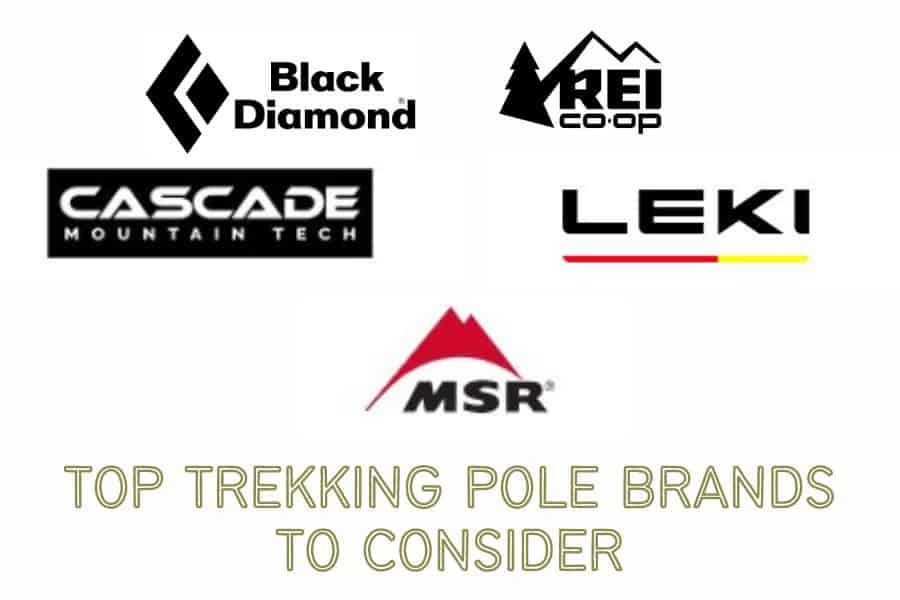
There are all sorts of trekking poles to choose from regarding what company sells them.
You should always research before just going with the first ones you see. The internet has made research so easy.
Take advantage of reviews, message forum discussions, videos, and blog posts concerning trekking poles that you’re considering.
I focus on hiking blogs and YouTube videos when researching hiking gear. I’ve also been burned when going to unknown brands’ cheaper items.
Sometimes cheap is good, and occasionally cheap breaks down on the first hike.
Let’s check out some of the more known brands that make trekking poles and information about them to see if their products meet your needs.
Black Diamond Trekking Poles

Black Diamond is one of the most well-known providers of trekking poles.
Black Diamond carries a vast number of trekking poles to meet your needs. They have poles specifically made for men, women, and even children.
They carry fixed-length, telescopic, and folding poles. Different poles are made with shaft materials, grips, and strap types.
You’re bound to find the set of poles that you require from Black Diamond.
I’ve used Black Diamond myself. The poles I have are a product of them. I’ve had the poles for years, and they still work well.
I’ve abused them for sure, and they’re still stable. I would recommend their poles, but they are a bit more expensive than others.
If the expense part is an issue, you should keep reading to see your other options.
REI Trekking Poles

REI is a widely used and trusted outdoor gear provider online and throughout communities worldwide.
The nice thing about REI is that they carry brand-name trekking poles and REI-branded poles.
The REI-branded gear seems sturdy and adequate but usually has a cheaper price tag.
REI will return gear that doesn’t meet the requirements of what they are supposed to do, and it isn’t challenging to return items.
I’ve bought a lot of REI-branded items because the prices are lower. I’ve never experienced a problem with the REI-branded gear I purchased.
I check the customer reviews, especially the bad ones, and I look for repeating alarming review trends.
If you need something cheaper than the big brand-name gear, REI might be your best solution.
LEKI Trekking Poles

LEKI trekking poles are often described as some of the best poles on the market.
The LEKI brand has been creating outdoor gear since the 1970s. Products are manufactured in Germany by German engineering.
The carbon fiber trekking poles are reviewed to provide shock resistance, and many people who use the aluminum options say they feel lighter than most other aluminum pole brands they’ve used.
I’ve never used the LEKI brand, but I have seen the name around outdoor gear suppliers I browsed through.
Based on some basic research, I’ve found significantly more positive reviews about LEKI trekking poles than negative ones.
LEKI brand trekking poles may be an excellent option, especially if you’re looking for quality carbon fiber options.
MSR Trekking Poles

MSR is a well-known brand that produces and sells hiking and outdoor gear.
MSR carried trekking poles for the hiking consumer.
There aren’t many options to choose from, but if you want to use equipment with the MSR brand name, there are a few poles to choose from. Prices are kind of high.
I have never used MSR trekking poles, but I’ve never heard anything wrong with them. I use their backpacking stove, the best “pocket rocket” type stove I’ve ever used.
If they’re putting the same quality in their poles as my stove, I’d recommend them.
MSR is a trusted and well-known outdoor brand, and their trekking poles may be ideal.
Cascade Trekking Poles

Cascade trekking poles provide a much cheaper option with a good brand reputation.
If you need a cheaper option for both carbon and aluminum trekking poles, Cascade is the brand you might want to go with.
They offer poles starting in the twenty-five dollar range and up. A few carbon fiber pole options are under a hundred dollars.
They sell telescopic, folding, and fixed-length trekking poles, too.
I’ve never used Cascade before, but based on the reviews; it doesn’t look like a bad company.
If you’re looking for a lower price range, I recommend checking this brand out and doing your research.
Whatever brand you choose, research to get the best trekking poles for your needs.
FAQs
Let’s check out some commonly asked questions and answers about trekking poles.
Are trekking poles worth it?
This depends on your needs of you as a hiker.
If you are having issues with stability and balance, then a trekking pole or pair of poles is something you should try out.
Do trekking poles make a difference?
For many people who use them, trekking poles make a big difference.
Trekking poles often give people with limited mobility a chance to keep hiking.
How heavy should trekking poles be?
Aluminum poles should have an average weight of around 20 ounces for the pair.
Carbon poles should be under 20 ounces for the pair.
Do hiking poles help your knees?
They can be very beneficial to the health of your knees, and in preventing knee pain after hiking.
When used correctly, hiking poles help reduce over-stretching, and strain on your body and joints.
What is the difference between a walking stick and a trekking pole?
A trekking pole is usually manufactured with plastics and metals containing various adjustment and shock-absorbing features.
A walking stick is usually a wooden staff with no unique features.
Do you need 1 or 2 trekking poles?
It depends on your need. I use one, because I only use a trekking pole for certain circumstances, such as steep descents and creek crossings.
For some people with more significant balancing issues, two poles are needed.
Do you burn more calories hiking with poles?
Some studies have shown that using trekking poles increases calorie burn by up to 15 to 20 percent more than without poles.
Also See: How Many Calories Does Hiking Burn? (7 Factors That Come Into Play)
What is better: aluminum or carbon trekking poles?
This depends on your weight reduction needs. A carbon fiber pole will be lighter than an aluminum pole, but a carbon pole will cost more money.
How long should my hiking pole be?
Adjust the length; your arm should be at a 90-degree angle starting from your elbow when the end is on the ground. That is how long the pole should be for all users.
Are trekking poles suitable for snow?
Trekking poles can be an extra stabilization for hiking in the snow.
Skiers use them while skiing, and the same with snowshoeing.
Should I bring trekking poles backpacking?
Due to a heavier pack which is often the case with backpacking, a trekking pole may be a good idea.
You could always start with one and add another if you need one after completing your hike.
How do I attach trekking poles to my backpack?
Most backpacks have external loops where you can attach the poles from the front to the rear side of the backpack.
Conclusion
And that concludes the complete guide to trekking poles. The above information should give you everything you need to know about trekking poles.
In my experience, I’ve needed them for some circumstances and not for others, as mentioned above.
Check each section of this article before getting your trekking poles to ensure you find the right ones.


